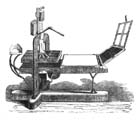Hone's Interesting History of the Memorable Blood Conspiracy...
Title Page Transcription:
HONE'S | INTERESTING HISTORY | OF THE MEMORABLE | BLOOD CONSPIRACY, | CARRIED ON BY | S. MACDANIEL, J. BERRY, J. EGAN, and J. SALMON, | Thief-Takers [gothic]| AND THEIR | TRIALS AND SENTENCES, | IN 1756 | FOR PROCURING TWO BOYS TO COMMIT A ROBBERY, IN ORDER TO GET THE | REWARD FOR THEIR CONVICTION, AND OBTAINING AN INNOCENT | LAD TO BE EXECUTED, HAVING SWORN AWAY THE LIVES | OF SEVENTY POOR CREATURES, AND RECEIVED | £1,720 FROM THE TREASURY | FOR THEIR | BLOOD-MONEY; | ALSO THE REASONS FOR WHICH THEY WERE SUFFERED TO ESCAPE THE | GALLOWS, AND ILLUSTRATIVE LEGAL AND CRITICAL | NOTES AND OBSERVATIONS | APPLICABLE TO | PRESENT CIRCUMSTANCES. | With a Portrait of Mac Daniel, after he was Pilloried. | London: [gothic] | PRINTED FOR WILLIAM HONE, 55, FLEET STREET. | 1816. | One Shilling.
Opposite title page is a sinister, full page engraving of Stephen Macdaniel by "Geo. Cruikshank, fecit." "drawn from Life in Newgate, June 10th 1756. From the Scarce Original Print. Published by W. Hone, 55, Fleet Street. September, 1816."
Title page verso: "J. Adlard, Printer, 23, Bartholomew Close."
Description:
This is a two-sheet octavo pamphlet totalling 32 pages (16 leaves). The most notable feature of the work is a kind of preface or prologue (pages 3-4) which encourages readers to see the parallels between the historical case identified in the title and some cases, such as that of Elizabeth Fenning, which had very recently played out in the courts and the newspapers. The implication, of course, is that the systems of power currently in place in England functioned in ways that were analogous to the "blood conspiracy" of the pamphlet's "interesting history." A second, and perhaps more profound and original observation here concerns the necessity of popular (i.e. media) oversight of the actions of justices and magistrates.
The writing in this section is quite strong, offering perhaps the clearest statement anywhere of Hone's developing notion of a "watchdog press." Here, for example, Hone notes a kind of malaise about law and the legal system, a non-critical, ill informed faith in "the system." This leads in turn to a problematic laxity:
"The indulgence claimed for the laws, must be extended to their administrators; and we are gravely called upon, not only to make the usual allowances for human infirmity, but absolutely to forego that vigilance and exposure of abuses, without which laws would soon become the mere discretion of the magistracy. Now, and with all due respect to the powers that be, it may be contended that almost every improvement, both in theory and practice, has originated in this country from EXTRA-OFFICIAL interference; and that public opinion, freely but decently expressed, is as essential to the regulation of the magistrate as the criminal. All the world know what implicit confidence engenders in this respect, and how round and voluble the excamation of 'All's well' is re-echoed from one worshipful quarter to another, until humane and public-spirited individuals penetrate into the painted sepulchre, and draw forth the rottennes and bones." ([3]). . . . and, if a poor person should be sent to the gallows on scant evidence (and, worse, with the prosecutor and judge being friends), those apathetic onlookers claim: "'It is a sad thing, to be sure; but the individual is hanged now, and if we meddle it will only unsettle the minds of the lower orders.'--Lower orders!--it would be difficult to discover an order lower than that which contains minds to whom such abuses are indifferent" ([3]).
Hone's point in publishing the present text is to point to a close resemblance between the earlier events and the present and to "shew that a system, which from time to time has produced such monstrous iniquity, is radically defective, and, in this sense, assist a noble-minded individual (Sir Samuel Romilly) in his ill-repaid labours" (4).
The text itself consists of an anecdotal story of the lives of the "thief-takers" who would set up some poor innocent as a criminal, have him hanged,and finally collect the reward--an average of £40 per conviction. It is estimated that they may have thus indirectly murdered more than 70 persons. What is more, when they were themselves taken and tried for murder, they were discharged because the law was not clear whether setting someone up for hanging constituted murder, and the powers that be chose not to argue out the point. A few "notes" to the text of the narrative offer references to the Fenning case and a some others.
